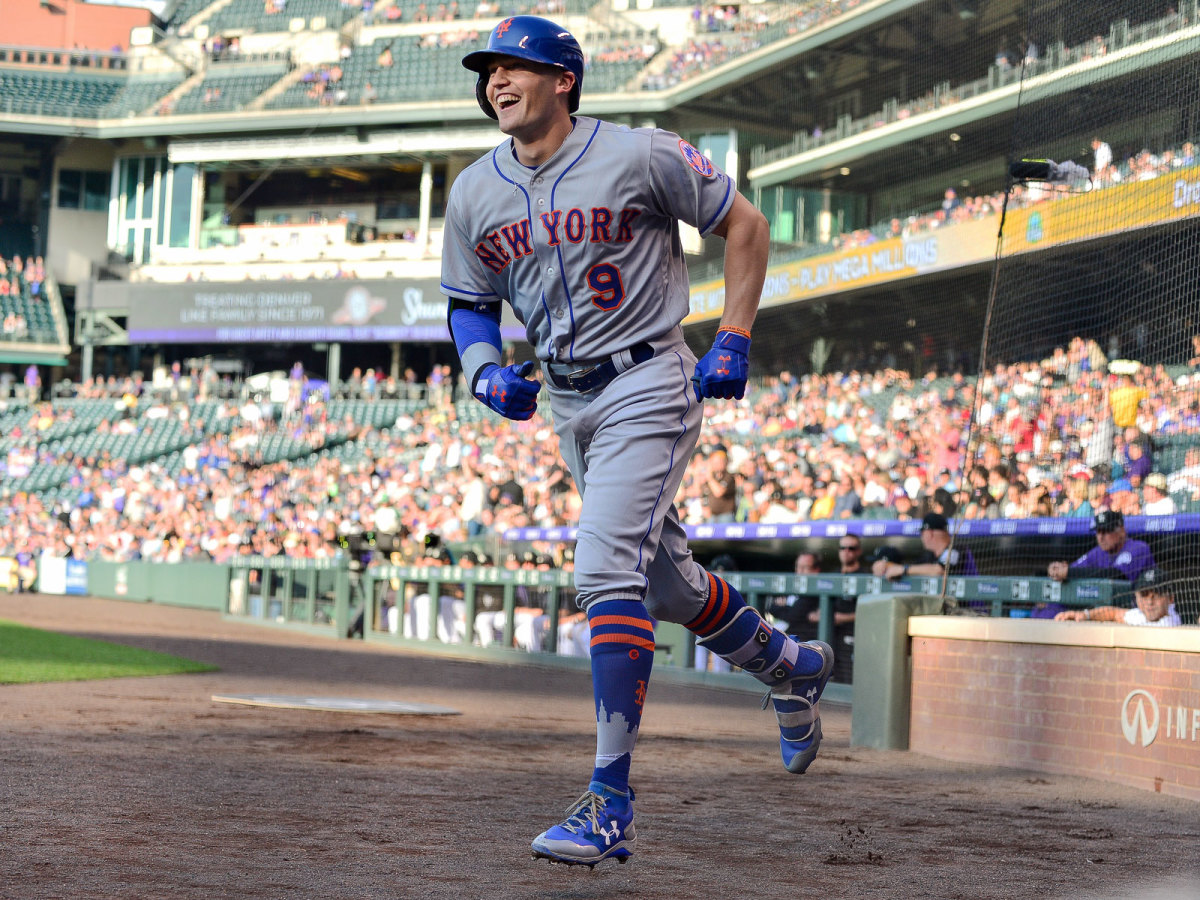A Reworked Swing Has Brandon Nimmo, Mets Smiling in Surprise Breakout Campaign

Why is this man smiling? His team—which he barely made out of camp and from which he was briefly demoted in April despite having a .600 OBP—is 31–40 and seven and a half games back of a wild-card spot after a 10–8 loss in Colorado on Wednesday.
But here he is beaming after an inside-the-park home run on Monday. Here he is glowing after a go-ahead homer on Sunday. Here he is over the moon after homering for the only run in what would become one of the Mets’ six losses so far in games where they held their opponent to two runs or fewer. The Mets lose and lose and lose, yet Brandon Nimmo grins and grins and grins. He cannot help himself. Tweeted starter Noah Syndergaard: “Nimmo is what we all strive to be internally. #benimmo.”
Indeed. As far as this team’s putrid offense—third from the bottom in the NL in runs scored per game—is concerned, the only performance more unexpected and outstanding than the one Nimmo has managed with his zygomaticus major is the one he has managed with his bat. Through Tuesday, the 25-year-old outfielder had a .287/.409/.596 batting line with 12 homers and seven stolen bases. His OPS, 1.005, would rank second in the NL only to Freddie Freeman’s if Nimmo had enough plate appearances to qualify. By wins above replacement, he is second among NL outfielders to Milwaukee’s Lorenzo Cain. Only A.J. Pollock, who is injured, has a higher slugging, and no NL outfielder with more than 100 plate appearances has done a better job of getting on base. Nimmo has a formidable case to make the All-Star team—and yet his production took the sport and, for that matter, his team so much by surprise that he does not even appear on the ballot.
Power Rankings: The Astros Refuse to Lose
And this is what makes Brandon Nimmo’s breakout such a strange story. While Nimmo’s good feelings toward being a Met are transparent, the team’s feelings for him have always been a little harder to read. In 2011, Nimmo became general manager Sandy Alderson’s inaugural first-round pick with the Mets, No. 13 overall, one spot before the Marlins took Jose Fernandez. Nimmo, from Cheyenne, was not only the first-ever first-rounder selected from Wyoming—he was the first-ever Wyomingite to go in the top five rounds. The state doesn’t have high school baseball, only American Legion, so a large fraction of Nimmo’s development took place in a barn beside his family home, where daily he would work out and hit off a tee. The Mets of 2011, saddled with aging veterans and financial issues (for a change) and not planning to contend anytime soon, were taken with the raw Nimmo’s potential and by his timeline. He’d be big-league ready in five or six years, and the Mets could afford to wait.

The team did rise again, with a pennant in 2015 and a wild-card spot a year later, but by that point the prospect-evaluation world had assumed Nimmo would fall short of his potential. John Sickels offered this sentiment before the 2017 season: “Perfect fourth outfielder/platoon bat.” John Manuel of Baseball America: “A borderline first-division regular, more of a second-division regular.” He had displayed exceptional plate discipline in the minors—his worst full-season OBP was .362—but little power had come. He had just five homers across three levels in 2015, 12 between the majors and minors in 2016, and just nine in 2017. Outsiders had good reason to think Nimmo would never develop any pop, and a corner outfielder without pop, no matter how superlative his on-base skills, is a hard sell.
It shouldn’t, though, have been a hard sell to the Mets. The 2017 club led the NL in home runs, but scored fewer runs than a league-average offense; a major culprit was the team’s 11th-ranked .320 OBP. Even a child could understand that if your team hits a lot of homers but doesn’t score very much, one solution would be to turn solo homers into two-run homers, and two-run shots into three-run shots and so on. Alderson, incidentally, made his career with this insight in the ’80s. Nevertheless, heading into the 2018 season, with Nimmo having posted a .379 OBP in 215 big-league plate appearances in 2017, New York’s front office decided to block him. In December, the Mets inked Jay Bruce—he of the .790 career OPS, lower than what Nimmo posted in ’17—to a three-year deal to play right field, never mind that Nimmo, as my colleague Tom Verducci chronicled earlier this month, had at the urging of Mets coaches reconfigured his swing late last season to unlock his power. Nimmo this year has substantially cut down on ground balls and started pulling the ball more. Consequently, he’s making a little less contact when he swings, but thanks to his selectivity he has steered clear of long slumps. Bruce, meanwhile, has muddled his way through injuries to a wretched .613 OPS.
There Are Too Many Strikeouts in Baseball: Here's How to Fix the Problem
The Mets have developed something of a pattern of giving up on players just as they successfully transform their swings. The Mets let Daniel Murphy and Justin Turner leave while on the cusp of breakouts—in Murphy’s case, the breakout had already begun while the Mets had him. Maybe they deserve partial credit for merely consigning Nimmo to a bench role rather than ditching him altogether (Pittsburgh reportedly wanted Nimmo in return for either Andrew McCutchen or Josh Harrison). And, in fairness, the line the Mets deployed in the preseason to defend their blocking of Nimmo—that he’d find playing time if things were meant to be—has proven true. If the organizational plan called for major injuries to Yoenis Cespedes and Juan Lagares, though, it’s a plan worth ditching.
Nimmo, who tweets out a passage from scripture every day, could probably come up with the right Bible verse to explain the vagaries of fate or perhaps the challenge of being blessed with good fortune as his brothers struggle. All I’ve got at my disposal is the Great American Songbook: “Keep on smilin’, ‘cause when you’re smilin’, baby, the whole world smiles with you.”
